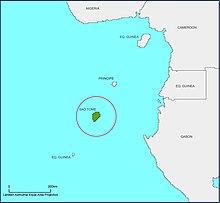Hyperolius molleri
| Hyperolius molleri | |
|---|---|

| |
| Scientific classification | |
| Domain: | Eukaryota |
| Kingdom: | Animalia |
| Phylum: | Chordata |
| Class: | Amphibia |
| Order: | Anura |
| Family: | Hyperoliidae |
| Genus: | Hyperolius |
| Species: | H. molleri
|
| Binomial name | |
| Hyperolius molleri (Bedriaga, 1892)
| |

| |
| range | |
| Synonyms[2] | |
|
Rappia molleri Bedriaga, 1892 | |
Hyperolius molleri is a species of frog in the family Hyperoliidae.[1][2][3] It is endemic to São Tomé Island. Records from Príncipe now refer to Hyperolius drewesi,[2] described as a distinct species in 2016.[4]
Taxonomy and systematics
[edit]The species was described by Jacques von Bedriaga in 1892[2] and was named after Adolphe F. Moller (1842–1920), a Portuguese botanist who collected in São Tomé.[5] It belongs to the so-called Hyperolius cinnamomeoventris species complex.[4][6] It can form hybrids with Hyperolius thomensis.[6]
Description
[edit]Adult males measure 24–31 mm (0.94–1.22 in) and adult females 31–33 mm (1.2–1.3 in) in snout–vent length. The dorsum is bright green or brown and hasfine spinosities. Juveniles have light dorsolateral lines. The ventrum is uniform white or red. The ventral sides of the legs are white to red. The pupil is horizontal.[3]
Habitat and conservation
[edit]Hyperolius molleri occurs in primary forest, farm bush, coconut groves, coffee plantations, and disturbed areas from near sea level to 1,420 m (4,660 ft) above sea level. The eggs are laid on leaf surfaces over still or very slow-moving water. The tadpoles develop in the water.[1]
Hyperolius molleri is common. It is not known to face significant threats, given its adaptability to habitat modification. It occurs in the Parque Natural Obô de São Tomé.[7]
References
[edit]- ^ a b c IUCN SSC Amphibian Specialist Group (2013). "Hyperolius molleri". IUCN Red List of Threatened Species. 2013: e.T56288A18390243. doi:10.2305/IUCN.UK.2013-2.RLTS.T56288A18390243.en. Retrieved 16 November 2021.
- ^ a b c d Frost, Darrel R. (2017). "Hyperolius molleri (Bedriaga, 1892)". Amphibian Species of the World: an Online Reference. Version 6.0. American Museum of Natural History. Retrieved 18 October 2017.
- ^ a b "Hyperolius molleri". AmphibiaWeb. University of California, Berkeley. 2008. Retrieved 18 October 2017.
- ^ a b Bell, Rayna C. (2016). "A new species of Hyperolius (Amphibia: Hyperoliidae) from Príncipe Island, Democratic Republic of São Tomé and Príncipe". Herpetologica. 72 (4): 343–351. doi:10.1655/Herpetologica-D-16-00008.1. S2CID 89895958.
- ^ Beolens, Bo; Watkins, Michael & Grayson, Michael (2013). The Eponym Dictionary of Amphibians. Pelagic Publishing. p. 143. ISBN 978-1-907807-42-8.
- ^ a b Bell, Rayna C.; Drewes, Robert C.; Zamudio, Kelly R. (2015). "Reed frog diversification in the Gulf of Guinea: Overseas dispersal, the progression rule, and in situ speciation". Evolution. 69 (4): 904–915. doi:10.1111/evo.12623. PMID 25715968. S2CID 43801840.
- ^ "DOPA: Parque Natural Obô de São Tomé". Joint Research Centre. Retrieved 1 November 2018.

